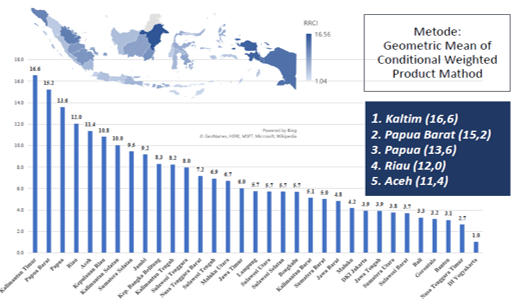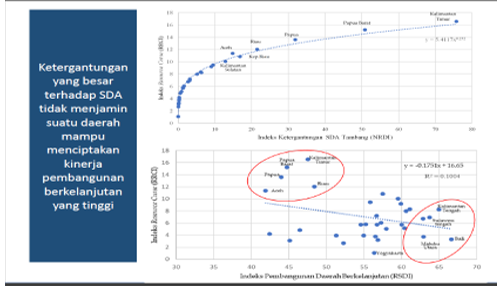The term of Natural Resource Curse is a paradoxal term from ‘blessing’ that is usually identical with the ownership of natural resources . Why? this is related to the phenomenon in which a resource rich country does not necessarily become a prosperous country. But on the contrary, it could makes a curse for the owner. Natural resources that are exploited and are expected to provide benefits to the community, sometimes are not inline with the negative impacts that caused by its exploitation process. Among them, massive damage to nature and the environment which results in a decrease in the quality of the environment-which as the source of human livelihood, such as water, land, and air pollution. Apart from the impact on the environment, it is not uncommon for this natural resource wealth to also trigger social conflicts, such as land conflicts with surrounding communities, as well as other impacts such as economic development gaps and inequality. In various studies, the Resource Curse occurs due to poor governance of natural resources.
Indonesia known as a country with abundant of natural resources. However, in term of economically and welfare, it is still far behind developed and other resource rich countries. Those situation lead to the question: Is Indonesia indicated as a country affected by the natural resource curse? To raise this issue, Publish What You Pay (PWYP) Indonesia held a PWYP Knowledge Forum (PKF) entitled “Resources Curse, Corruption and Natural Resources Governance (Resources Curse Index for Mineral and Coal Mining Sector in Indonesia) on August 6, 2020. PKF is a forum for discussion and knowledge sharing held regularly by the PWYP Indonesia coalition, with the aim of increasing understanding and capacity, as well as developing public discourse related to current issues and policies (that’s relatively new) are currently in the spotlight and being public concern.
PKF, which is conducted by online has invited Dr. Hania Rahma, an expert of economic and natural resources issues as well as an academic from the University of Indonesia (UI) who discussed her dissertation of her study in Bogor Agricultural Institute (IPB) regarding the Natural Resource Curse (NRC) phenomenon in regional development in Indonesia. The focus of her dissertation is mainly in the Natural Resources sector of oil, gas, also mineral and coal mining sector, which have a significant revenue sharing with the regional government. Interestingly, her dissertation is not only limited to answering whether Indonesia has fallen into the natural resource curse, but also tries to answer how much the curse is, which is stated in the Regional Resource Curse Indonesia (RRCI) index to measure the degree of curse of natural resources in 33 provinces in Indonesia. The index is obtained by first measuring the Natural Resource Dependency Index (NRDI) which takes indicators including Profit Sharing Funds to the regional government (DBH), Non-Tax State Revenues (PNBP), and so on. Then the sustainable development index or the Regional Sustainability Development Index (RSDI) at the regional / provincial level is measured by the Human Development Index (HDI), unemployment rate, environmental quality, and others.
The results of her research revealed that the NRC phenomenon occured at the local or provincial level in Indonesia. By being connected with the variable level of regional dependence on natural resources and the variable of sustainable development, it is found 4 (four) things. First, the large amount of revenue from mining producing regions does not guarantee the realization of massive sustainable development. Second, regions that extracted the natural resources are vulnerable to the phenomenon of the natural resource curse. Third, regions that rely on oil and natural gas are more susceptible to NRC than areas that produce minerals and coal. Fourth, the scores of regions with high sustainability scores, have a small inclination or far from the NRC phenomenon.
The study found (5) five main provinces that was experiencing with the NRC, namely: East Kalimantan, West Papua, Papua, Riau, and Aceh. Meanwhile, the province that has the highest level of sustainability is Bali.
Picture 1.1
Regional Resource Curse Index (RRCI)

Picture 1.2 Natural Resources Dependency Index (NRDI) and Sustainable Regional Development Index (RSDI)
Causal conditions that can explain the occurrence of NRC phenomenon are including dominance of mining Gross Domestic Regional Product-compared to GDRP of non-mining sector; corruption in government areas; integrity of regional head/leader; business licenses that have a minimum or less clean and clear status; allocation of funds for education, health, and economic spending are low.
Not only that, this study also found which variables that had a strong influence and which variables had an indirect effect. The strongest variables are the integrity of the regional head/leader, mining oligarchy, integrity of the government bureaucracy and the level of corruption, while the influence of the integrity of the regional head/leader on environmental quality has a very strong influence and the integrity of the regional head/leader on reclamation and royalties is reported to have a strong influence in influencing an regional that has experienced into the NRC.
Corruption is also the reason why the NRC phenomenon can be occured. The forms are bribery and gratuities, conflicts of interest, and natural resources assets that are never considered as state property. Another data that is no less surprisingly is there are many regional heads/leaders with the status of corruptors are spread in the provinces with a high NRC index such as in Aceh, Riau, Jambi, South Sumatra, Riau, NTB, Central Kalimantan, South Kalimantan, East Kalimantan, Central Sulawesi, Southeast Sulawesi, North Maluku, and Papua.
A number of recommendations were made to improve the natural resource governance. There are: the utilization of natural resources needs to be carried out in efficiently and sustainable manner; In order to integrate and synergize the interests of stakeholders, it is necessary to build a framework for natural resource management including natural resource funds in the future. In addition, it is necessary to emphasize that’s We are not being continuously has oriented to GDP in measuring the economic progress per see, it needs to be oriented towards fulfilling human rights needs through a social foundation and ecological ceiling as referred to in the Doughnut Economic approach. (Wicitra / Ary)